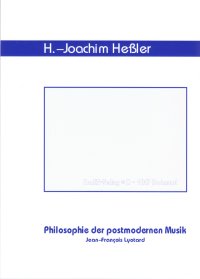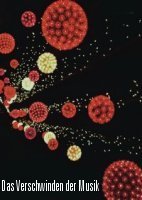Der zornige Baron [The angry Baron]
 The principle of discontinuity in the life and the concept of composition of Charles Mingus jr.
The principle of discontinuity in the life and the concept of composition of Charles Mingus jr.
United Dictions Of Music, ISBN 3-942677-00-4
"With his dissertation Hans-Joachim Hessler makes a scientific contribution to the jazz of the last century, in a refreshing way he sets itself apart from the otherwise abound present narrative representations and he is questioning some paradigms of contemporary jazz research. His contribution is overdue [...] and [... ] his knowledge [can] serve as a basis for more exciting research projects" (Jazz'n'More 05/2013, p. 65).
"...an ambitious study on the personality and music of Charles Mingus" (Dr. Wolfram Knauer, Director of the Darmstadt Jazz Institute).
"...an unusual recipe of music-biographical, philosophical as well as scientific understanding, which asks a lot of the vigilant reader, thereby opening up entirely new dimensions" (Ray Finkenberger-Lewin in the Recording Magazine 4/2011).
"Then again, further contexts fascinate: Hessler analyses a piece by Mingus in comparison with Richard Strauss; Mingus' striving for autonomy appears aside US politics and Adorno, his aggressive rage aside psychoanalysis. And there is another topic, namely: the rising of ostracized "nigger music" to sound art - which the author here describes with a virtuoso's joy of debauchery" (Vienna Newspaper dated July 7, 2011).
"Hessler's great merit is that he demonstrates consistently how Mingus used his music as an expression of social protest. And so, the most impressive passages of this book are those, in which Hessler places key works by Mingus in the historical context of the McCarthy era, the civil rights movement and the fight of the Afro-Americans for equal rights. He values Mingus highly as the free thinker that he was, his civil disobedience, and he describes the bass player as the founder of his own record label, who took control over the conditions of production of his music" (Guenther Huesmann on May 5, 2011 in the NOWJazz Magazine, SWR2).
Hessler "confronts the reader with the depressing racism in the USA and can explain coherently how this racism possibly caused the ruptures in Mingus' music" (Dr. Michael Kuhlmann in the broadcast JazzFacts on Deutschlandfunk dated May 20, 2011).
"Hessler's book shows clearly what Charles Mingus can mean to the ears. What the author reads out of a single piece of music, shows how little substance many a piece of jazz has nowadays [...]. It is worthwhile going to the effort of reading" (Henry Altmann in the broadcast PlayJazz! dated July 21, 2011, NDR-Info).
"...Hessler's study is more than a biography" (Reiner Kobe in the magazine Jazzpodium 7/8/2011).
"Elementary joy of reading: there are books that are full of stories, information and analyses, and turn out to be profound sources of thought-provoking impulses" (Gerd Filtgen in the magazine Fono-Forum 10/2011).
"The present dissertation might well be the most comprehensive scientific work on Charles Mingus, at least in German language. [...] It classifies one of the most important representatives of free music, which is colloquially called 'jazz', into interdisciplinary structures; probably, Mingus has never been considered under this aspect. The piece of work extends far beyond biographical descriptions, [...] but instead develops many questions on the political, societal, sociological and psychological meaning of musical phenomenon" (Bernhard Hefele in IFB 20, 2012).
"[The reader] however learns more about American society and the American citizen and musician Charles Mingus jr. as music biographers usually reveal. Hessler […] retraces the youth of the bass player - and thereby refers back to the prospects of a black boy who, in a racist world, was denied a musical career in the field of classical music, who acquired a black identity and, on the other hand, throughout his entire life was inspired by European, so-called 'classical' music. He draws on biographical facts, refers in an illustrating way to texts of the Beat authors and does what the least jazz biographers do: he analyses the compositions on the basis of sheet music. […] After reading the 589 page analysis, one listens to Mingus' pieces in a different way than before" (RONDO 1/2012, p. 35).
"[The book] offers [...] well-grounded analyses of Mingus' compositional style on the background of an US-American society, in which this creative agitator could find no peace. The music of a free spirit who with his music fought for equal rights and against a still shockingly present racism. The title of the book leans on the fact that Mingus, in early days, called himself "Charles 'Baron' Mingus" - in leaning on his idol Duke Ellington. Ellington, the great jazz composer, who was the first person to lift jazz to an art, was actually called Edward Kennedy Ellington - and because of his fine manners, people called him duke, the prince. Also, there already was a count: William 'Count' Basie. Therefore, there was only the title of baron left for Mingus. The young musician took it in order to bow to his idol Duke Ellington - and also, in order to propagate jazz as an high art. […] In the above mentioned book by Hans-Joachim Hessler, one can read extensive examinations of "Pithecanthropus erectus" and other central pieces by Mingus, not least by means of sheet music examples. This is worth it in any case. Some things become more clear, which one perhaps only sort-of knew beforehand" (Roland Spiegel in the broadcast "Klassik plus" on BR-Klassik with the title "Der Ungezaehmte: Portraet des Jazzmusikers Charles Mingus" [The untamed: portrait of the jazz musician Charles Mingus] on April 22, 2012)
"...with an abundance of interesting information..." (Henning Sieverts in the broadcast "Jazztoday" dated April 23, 2012, Bayerischer Rundfunk).
"Passive resistance, as well as an irrepressible rebellion, run like a thread through the work of this musician, who has experienced what it means to hit rock bottom - and this is to be understood not only in a social, but also in a psychological sense. And of course, the race problematic plays into this, the orientation of a complex character in a complicated social web of relations. Hans-Joachim Hessler throws a light on all of this in a remarkable book which is worthwhile reading […]. In a multi-perspective way, Joachim Hessler describes and analyses Charles Mingus as an artist personality who is grounded in many coordinate systems and therefore works in highly versatile - that is in a discontinual way - in terms of his creativity" (Bert Noglik in the broadcast "Classics" dated June 28, 2012, MDR-Figaro).
"Michel Foucault and Jean François Lyotard stand in the centre [...]. After all, Hessler thoroughly scrutinizes Mingus' descent, life and work, with models taken from various scientific disciplines, sociology, psychology, history, cognitive science" (Henry Altmann in JAZZTHETIK 11+12/2011, p. 66-67).
Das Verschwinden der Musik [The disappearance of music]
 or: Pope Gregory I. and Madonna, the godess of love, search for Jean Baudrillard, their seducer
or: Pope Gregory I. and Madonna, the godess of love, search for Jean Baudrillard, their seducer
NonEM Publishing Company, ISBN 3-935744-06-4
On March 6, 2008 was the first anniversary of the death of the eminent philosopher, sociologist and media-theoretician Jean Baudrillard. Hans-Joachim Hessler - author of the "Philosophy of Postmodern Music" (see below) - used the occasion of Baudrillard's death to scrutinize more closely the effects of the theories of this probably most important representative of post-historic thought in terms of the aesthetics and sciences of music. Within the context of the science of music, he thereby for the first time dealt with a phenomenon which has been discussed in the science of art for decades, for instance in respect to Andy Warhol: the disappearance of art. Isn't it obvious that, if art is disappearing within the overabundance of art products generated by the digital world, also the art of "sound" is simultaneously becoming extinct through the transaesthetics of "music-sounding-everywhere-always"?
From the content: according to a decription of Baudrillard's theory of the orders of simulacra, this thought construct can be applied to basic stations of music history: in relation to the monochrome age with the example of Gregorian musicology and the famous bull "Docta sanctorum partum" John XXII; in terms of the age of imitation with Mozart's compositions for various music machines; for the age of production with the help of Satie's "Vexations" in the sense of "tortured" reproductions; in the context of the age of simulation with the exact consideration of Varèse's "Poème Electronique" as well as Boulez's "Structures". As an example of today's fractal, that is digital, age, there is a comparison of the Monroe reproductions by Warhol and Madonna ("Material Girl"). Finally, there is the solution strategy of "Trompe l'Œil", which Baudrillard suggested and which according to his view was and is able to counter simulated reality by means of illusion.
Philosophie der postmodernen Musik [Philosophy of Postmodern Music]
 Jean-François Lyotard
Jean-François Lyotard
NonEM Publishing Company, ISBN 3-935744-00-5
"In the first half of the book, the author clarifies - in an indeed comprehensible way - important basic
concepts of Jean François Lyotard's philosophy: his pluralistic understanding of postmodernity in
delineation to Charles Jenck's eclecticism, his theory of discourse which grounds on »controversy« as well
as his aesthetic of the exalted and - in recourse to Friedrich Nietzsche - of laughter. In the second half,
the author describes some elected works by John Cage and Mauricio Kagel using the philosophemes which he had
discussed beforehand..." (Rainer Nonnenmann in the Neue Zeitschrift für Musik [New Journal for Music] 6/2002, p. 82).
"However, postmodernity in the variation of Kagel demeaned itself in a way that was so devoted to methods -
if not to say pious - that its revolutionary program took place almost unnoticed. [...] And of course, the
quickly growing oeuvre of Kagel wandered through all susceptible actualities. In this case, the making
dramatic of the instrumental action, presented in an exemplary way in the trio-composition Match, which
H.-Joachim Hessler recently interpreted in a philosophically grounded analysis as a demonstration of the
»controversy« of discourses which Lyotard describes" (Hans-Klaus Jungheinrich in the Frankfurter Rundschau dated December 24,2001 to the occasion of the 70th birthday of Mauricio Kagel).
"Hessler rightly states that Theodor W. Adorno's music philosophy no longer reflects many phenomenon of the
20th century in an adequate way. [...] Hessler contrasts the »compulsive« traits of Adorno's material with a
flexible understanding of material as it can be found in Jean-Francois Lyotard [...]. For the French
philosopher, musical material obviously is nothing more than physically measurable air vibration..."
(Hans-Klaus Jungheinrich in Title-Magazin, dated July 27, 2012).
Arbeitsfeld Schule und Musikschule [School and Music School as fields of work]
 For the artistic training of music teachers - an integrative concept
For the artistic training of music teachers - an integrative concept
United Dictions Of Music, ISBN 3-942677-02-8
In the 2nd edition of the book, the author Hans-Joachim Hessler explicitly refers to the G8-syllabus for music, which has become effective on August 1, 2011, as well as to the recently published studies on making music in class with the wind section, the so-called "Blaeserklassen" [wind section classes].
From the content: »To be student-oriented implies also to 'pick the students up where they are'. In terms of the subject of music, this usually means 'picking the students up' in the various areas of rock and pop music, in order to introduce them to the different other areas which music has to offer. [...] However, if teaching music in a student-oriented way is found to be the pedagogical guideline, then such a definition of music teaching needs to distance itself from a concept of music which is based one-sidedly on tradition, and instead needs to allow as well for music pedagogy a concept of music which includes everything that can be heard. [...] Unfortunately, the institutions that train music teachers are in the most part still oriented according to the principle of 'tradition'. Although the range of seminar and teaching course offerings shows an increase of emphasis on music that lies outside of the principle of tradition, the training in these areas is nonetheless insufficient considering the actual situation in schools and the practical aspects of teaching. [...] The integrative concept is based in principle on two columns. On the one hand, there is the column which in the regulations is called the 'principle of tradition', and on the other hand there is the column of jazz, understood in the broader sense as world music. That is to say, the integrative concept implies relaying artistically the whole variety of 'classical' music, as well as relaying the varied manifestations of jazz. Both columns should be combined in terms of a [...] 'non-hierarchical integration'.«
Die Erdanziehung und der Tanz der Finger auf der Klaviatur [Gravity and the dance of the fingers on the claviature]
![]() A few general suggestions for achieving a solid piano technique
A few general suggestions for achieving a solid piano technique
United Dictions Of Music, ISBN 978-3-942677-03-5
From the content: »So on the one hand, a futile argument has broken out whether such natural scientific legitimation is necessary or not; on the other hand, the various pedagogical schools are fighting one another, and rely only on experience. Hereby, there exist page-long discourses, whole chapters, parentheses, which only make it more difficult to read such pieces of work and do little to help the actual issue, since no piano method will neither be able to, nor should, assert its claim to be the only valid one. The pianistic music life and the making of piano music are too manifold as that such a claim could by any means be kept upright. This present work, therefore, does not intend to take part in this discourse and - as the subtitle already suggests - intends only to give general stimulations [...]. Further, I will try to show, with the help of many images, very concrete and basic exercises in a way that they are comprehensible for anyone who knows the piano even a bit. The reason is that most publications that I know are not very concrete or comprehensible, but instead reside on a very advanced virtuoso- level and easily drift off into piano-philosophical and/or -ideological discussions. Also, the publications lack images to illustrate what has been described - which makes them even more difficult to comprehend, or even impossible to understand in the cases where the descriptions are not very precise.«
Der Tristan-Roman des Gottfried von Straßburg und Richard Wagners Tristan und Isolde [The Tristan novel of Gottfried of Straßburg and Richard Wagner's Tristan and Isolde]

A comparison with a focus on ethics and aesthetics
NonEM Publishing Company, ISBN 3-935744-02-1
From the preface: »"There will have been no greater amount of book titles that have been written on any human being proximate Jesus and Napoleon as on Richard Wagner…" [...], such is the probably most original, but meanwhile normative beginning on any work on the very musician and poet. And, as the conjunctive case shows, the quoted sentence here is itself a quotation, that is to say, a quotation within the quotation. Why another piece of work on Richard Wagner? Because it is at the same time a piece of work on Gottfried of Straßburg [...]. A comparison of these two artists, who dealt with the same subject matter in such different life conditions, has been undertaken very seldom. Further, I am not aware of any other piece of work that places the same emphases as the present work. Therefore, the various insights of this piece of work will not convey anything new to the one or other, however they might nonetheless find the comparison, which is undertaken here, interesting. And then there might be those readers who have only considered the one or other aspect of this work. For these people, this piece of work could also be of interest.«
Das Lied im Nationalsozialismus [The Song in National Socialism]

An analysis of three exemplary songs with special consideration of the song lyrics and their structure
NonEM Publishing Company, ISBN 3-935744-03-X
From the preface: »Michael Jung's dissertation of 1989 is the sofar most comprehensive empirical study on song lyrics during National Socialism. In the area of music education, there also exist a couple of publications. However, in the course of occupying myself with the subject matter, I have not come across any research findings on the psychological effect of songs, of song lyrics, on the psychological interaction of music and text, nor on the scientific analysis of the language and literature of song lyrics in National Socialism. In this present piece of work, I try to give - through the analysis of three exemplary songs and accordingly song lyrics - a small, humble linguistic impetus in the direction of a yet unexplored field of study. So on the one hand, I have chosen songs that have been published in very many song books, which implies that they were, or were supposed to, be sung very frequently. On the other hand, the chosen songs represent the three major categories, in which songs were classified in song books after Hitler's takeover.«


